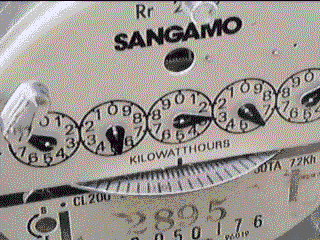Questions on Energy Transitions
 Q16. Electricity meters now have a digital readout, but many homes still have old electricity meters in them. These meters have a mechanical dial that turns when electricity in the home is being used to drive an appliance. The turning dial rotates counters on a display to show how much energy has been converted into another form in your house. It displays how many kWh you have used. The dial will turn many times before you use 1kWh. Therefore for short energy use experiments you have to count the turns rather than look at the display.
Q16. Electricity meters now have a digital readout, but many homes still have old electricity meters in them. These meters have a mechanical dial that turns when electricity in the home is being used to drive an appliance. The turning dial rotates counters on a display to show how much energy has been converted into another form in your house. It displays how many kWh you have used. The dial will turn many times before you use 1kWh. Therefore for short energy use experiments you have to count the turns rather than look at the display.
A group of students used a classroom version of such an electricity meter to measure how much electrical energy was used in a couple ofminutes as they performed each of the following household tasks:
a) boiled a kettle of water;
b) swept the carpet with a vacuum cleaner;
c) did the ironing.
Here are their results:
Time/s |
Number of turns of the electricity meter dial |
|
Kettle |
Vacuum Cleaner |
Iron |
0 |
0 |
0 |
0 |
16 |
4 |
1 |
2 |
32 |
8 |
2 |
4 |
43 |
12 |
3 |
4 |
64 |
16 |
4 |
4 |
80 |
20 |
5 |
4 |
96 |
24 |
6 |
6 |
112 |
28 |
7 |
8 |
128 |
32 |
8 |
10 |
(a) For each of the appliances, plot a graph of 'number of turns of the electricity meter dial' against 'time taken'. (10 marks)
(b) How can you tell from your graph which appliance used the most electricity in two minutes? (1 mark)
(c) Use your graph to find out how many times did the dial turn for each of the appliances in 24 seconds? (4 marks)
(d) Use your graph to find out how long did it take each of the appliances to make the dial turn round three times? (4 marks)
(e) Explain how the function of the iron makes the graph for the iron looks rather different to the graph for the kettle and the hoover. (2 marks)
(Total 21 marks)




 Q16. Electricity meters now have a digital readout, but many homes still have old electricity meters in them. These meters have a mechanical dial that turns when electricity in the home is being used to drive an appliance. The turning dial rotates counters on a display to show how much energy has been converted into another form in your house. It displays how many kWh you have used. The dial will turn many times before you use 1kWh. Therefore for short energy use experiments you have to count the turns rather than look at the display.
Q16. Electricity meters now have a digital readout, but many homes still have old electricity meters in them. These meters have a mechanical dial that turns when electricity in the home is being used to drive an appliance. The turning dial rotates counters on a display to show how much energy has been converted into another form in your house. It displays how many kWh you have used. The dial will turn many times before you use 1kWh. Therefore for short energy use experiments you have to count the turns rather than look at the display.


